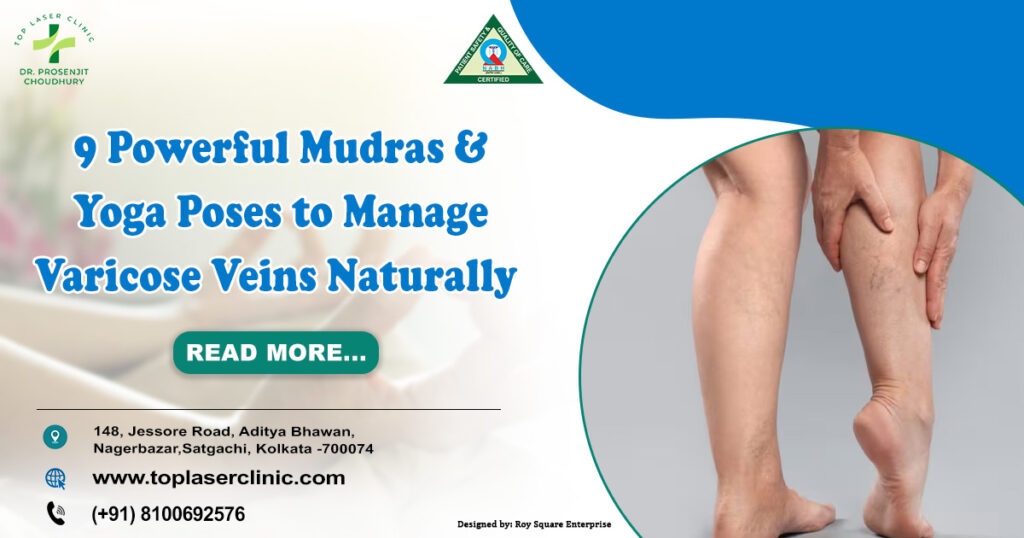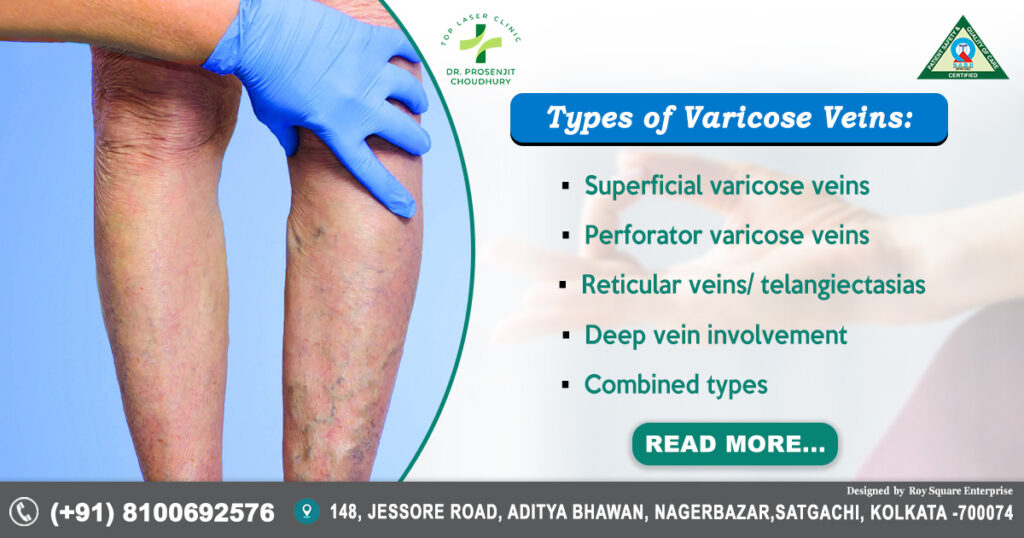
1. Introduction
Varicose veins—those twisted, enlarged veins visible just beneath the skin—can cause discomfort, heaviness, aching, and cosmetic concerns. While medical and surgical treatments play a crucial role, adjunctive natural practices like mudras (yogic gestures) and yogasanas (yoga postures) can support circulation, reduce symptoms, and improve overall vascular health.
In this detailed guide, you’ll find a systematic exploration: from fundamentals (causes, risk factors, diagnosis) to integrative therapeutic strategies (mudras and yoga), myth-busting, frequently asked questions, and a perspective on why a specialized centre like Top Laser Clinic under Dr. Prosenjit Choudhury, Consultant General & Laparoscopy Surgeon can add value to your care journey.
At first, you must know the basics about varicose veins. Let’s see few insights…
2. What Are Varicose Veins?
- Definition
Varicose veins are dilated, elongated, tortuous veins—most commonly in the lower limbs—arising due to incompetent venous valves and venous hypertension. - Pathophysiology
In healthy veins, one-way valves prevent backward (retrograde) flow of blood. If valves weaken or fail, blood pools, pressure builds, and veins dilate. - These changes are more evident when standing or after prolonged periods of leg dependency.
3. Symptoms:
Individuals with varicose veins may experience:
- Visible bulging, twisted veins (blue, purple, or skin-coloured)
- Sensation of heaviness, dragging or aching in legs
- Swelling (especially ankles)
- Throbbing, burning, or cramping in calves
- Itching or restless legs
- Skin changes overlying veins: discoloration, dryness, eczema
- In severe cases: ulceration, bleeding from veins
Symptoms may worsen by evening, after prolonged standing, or in warm weather.

4. Types:
Varicose veins can be classified by anatomy, depth, or severity:
- Superficial varicose veins: involve the superficial venous system (great saphenous vein, small saphenous).
- Perforator varicose veins: where veins connect superficial to deep systems.
- Reticular veins / telangiectasias: smaller, less symptomatic venous dilation.
- Deep vein involvement: less common, but may present with features of chronic venous insufficiency.
- Combined types: a mixture of superficial and perforator involvement.
A clinical classification system often used is the CEAP classification (Clinical, Etiological, Anatomical, and Pathophysiological) to grade severity.
5. Causes:
The genesis of varicose veins is multifactorial:
- Weak or damaged venous valve structure
- Chronic venous hypertension (e.g. increased pressure from standing, obesity)
- Inflammation of vein walls (venous wall remodelling)
- Genetic predisposition or familial tendency
- Hormonal factors (e.g. pregnancy, hormonal therapy)
- Prolonged standing or sedentary lifestyles
- Trauma to veins
Over time, increased venous pressure causes dilation of the venous walls and further valve incompetence, creating a vicious cycle.
6. Mudras & Yoga Exercises for Varicose Veins:
In this section, we present mudras (hand/energy gestures) and yoga asanas / exercises that can be safely integrated (with medical clearance) to support venous health. These are adjuncts—not substitutes—for medical and procedural treatment, especially in moderate or advanced disease.
7. Key Principles:
- Encourage venous return (leg elevation, inversion, muscle pump)
- Improve microcirculation and capillary health
- Promote relaxation and reduce venous pressure
- Enhance autonomic balance (reduce sympathetic overactivity)
8. Recommended Mudras:
While scientific evidence is limited, traditional yogic texts and anecdotal practice suggest the following:
- Apaan Vayu Mudras
- Purpose: Helps regulate downward flow of energy, aids circulatory balance in legs.How to do: Join tips of middle and ring fingers to t ip of thumb; index and little finger remain extended. Practice in a comfortable seated posture (Sukhasana or Vajrasana). Hold for 10–15 minutes (possibly twice daily).
- Suggested benefit: Support venous outflow in lower limbs. (Often recommended in traditional yoga circles)
- Prithvi Mudras
- Purpose: Strengthens tissues, supports circulation.How to do: Touch tip of ring finger to thumb, other fingers remain extended. Can be done while seated or meditative posture.
- Suggested benefit: Improves circulation and supports venous walls (by improving nutrient flow to tissues).
- Viparita Karani (Legs-Up-Wall Pose / Inversion Mudras)
- As a mudra/pose: lying supine, legs extended vertical against a wall (or supported), and arms relaxed. It is considered both a restorative pose and mudra (in inversion tradition)Purpose: Reduces gravitational stress on veins, promotes venous return, and drains venous blood from legs upward.
- How to do: Lie with your hips close to a wall, legs up the vertical wall, rest your back on a mat, arms relaxed to sides. Stay 5–20 minutes, breathing deeply.
- Anjali Mudras (Hands in Prayer at Heart Centre)
- Classical mudra of balance: hands pressed together at the chest.Used during pranayama or seated poses to center energy and promote calm breathing (which can reduce venous pressure by lowering sympathetic tone).
- Often combined with breathing in yogic routines for vascular benefits
When practicing mudras, maintain relaxed lungs, gentle awareness of legs, and avoid strain.
9. Recommended Yogasanas & Exercises:
Below are yoga postures and leg-focused movements beneficial for varicose veins. These help strengthen calf pumps, open venous channels, and reduce venous stasis.
- Viparita Karani / Legs Up the Wall (as above)
- Already described; very safe, restorative inversion.
- Tadasana (Mountain Pose) with Heel Raises
- Stand with feet hip-width apart, arms overhead or by sides.
- Rise onto toes (heel lifts) slowly, then lower. Repeat 10–20 times.
- Benefit: Activates calf muscle pump, improving venous return.
- Paschimottanasana (Seated Forward Bend)
- Sit with legs extended, inhale, lengthen spine; exhale, hinge from hips to fold over legs.
- This stretches hamstrings, gently compresses posterior leg circulation, and improves overall leg circulation.
- Sarvangasana (Shoulder Stand) / Supported Shoulder Stand
- If safe for your neck and spine, inversion asana to reduce venous stress.
- Use support (blankets, blocks) for safety.
- Setu Bandhasana (Bridge Pose)
- Lie supine, bend knees, feet flat. Lift hips, press feet into floor, support hips with hands or blocks.
- Encourages pelvic venous drainage, gently mobilizes lower back.
- Uttanasana (Standing Forward Bend)
- From standing, bend at hips, let head hang, knees slightly bent.
- Encourages venous return via inversion and stretch.
- Pawanmuktasana / Wind-Releasing Pose (single leg or both legs)
- Lie supine; draw one or both knees to chest. Maintain for 30 seconds.
- Relieves tension in lower back and supports leg circulation.
- Ankle Rotations & Foot Circles
- While sitting or lying, rotate ankles in circles; wiggle toes.
- Activates microcirculation in feet and lower legs.
- Calf Stretch / Gastrocnemius Stretch
- Stand facing a wall, one foot back, heel down, lean forward.
- Feels stretch in calf; hold 30 sec each leg.
- Walking / Leg Raises (non-yoga but important)
- Brisk walking for 15–30 min daily
- Lying down with leg lifts: supine, raise one leg straight up, hold few seconds, lower, alternate.
10. Suggested Routine & Tips
- Begin with 5–10 min of mudra + pranayama (deep breathing, slow exhales)
- Move into gentle yoga asanas, including inversions or legs-up poses
- Include calf raises, ankle rotations, walking
- End with relaxation (Savasana), ideally with legs elevated
- Frequency: daily or every other day, with modifications as needed
- Always listen to your body — avoid pain, strain, or excessive pressure
These practices support venous health, reduce symptoms, enhance comfort, and complement medical treatments. But always consult your vascular specialist before beginning.
11. Top 10 Frequently Asked Questions
- Can mudras and yoga fully replace medical treatment for varicose veins?
No—they are complementary. For moderate to advanced vein disease, interventional or surgical treatments are often needed. - Is it safe to do inversion yoga if I have varicose veins?
In many cases, gentle inversions (like Viparita Karani) are safe. But avoid if you have glaucoma, hypertension, hernia, or neck issues. Always consult your physician or vascular specialist. - How long before I see benefits from yoga & mudra practice?
Some relief (less heaviness, better comfort) may appear within a few weeks; structural vascular changes take months or more. - Will compression stockings conflict with yoga practice?
They’re generally helpful; you can wear light compression during standing and remove during rests. Follow your clinician’s guidance. - Can yoga damage veins?
Overstretching, forced inversions, or high-impact poses may be harmful. Practice gently, listen to your body, and avoid strain. - How often should I practice these mudras and asanas?
Ideally daily, or at least 5 times weekly, adjusting for your condition and tolerance. - Are these practices safe during pregnancy?
Many gentle yoga practices are adaptable during pregnancy, but inversions may require modification. Consult your obstetrician. - Will weight loss improve varicose veins?
Yes—reducing excess weight lowers venous pressure and helps symptom relief. - Do these practices help prevent new varicose veins?
They support vascular health, so they may reduce or slow new vein formation when combined with healthy habits. - When should I see a specialist rather than relying on yoga?
If you have pain, ulceration, bleeding, rapid worsening, or if symptoms persist despite conservative measures—consult a vascular surgeon or specialist, such as at Top Laser Clinic under Dr. Prosenjit Choudhury.
12. Why Choose Top Laser Clinic
- Expertise in minimally invasive vascular and laser treatments (endogenous laser ablation, radiofrequency, etc.).
- Cutting-edge diagnostics (venous Doppler, duplex imaging) for precise mapping.
- Integrated holistic care: combining procedural intervention with lifestyle, yoga, and supportive practices.
- Personalized recovery plans with guidance on safe yoga or mudra practices.
- Focus on patient comfort, quicker recovery, and low complication rates.
- Reputation for successful benign vascular and venous condition treatments.
Conclusion
Varicose veins are more than a cosmetic concern—they can impact comfort, mobility, and vascular health. While modern medical and interventional approaches remain cornerstone treatments, mudras and yogasanas can be potent complementary tools to support circulation, reduce symptoms, and enhance recovery.
Adopting a consistent, gentle practice of mudras (such as Apaan Vayu Mudras, Prithvi Mudras , and Viparita Karani mudras) and yoga postures (calf raises, inversions, bridge, forward bends) can assist your venous health journey. Coupled with lifestyle modifications, compression therapy, and specialist care, they create a holistic framework.
If you are considering advanced intervention, the expertise of Top Laser Clinic under Dr. Prosenjit Choudhury ensures that your treatment is precise, minimally invasive, and aligned with long-term vascular wellness.
Begin your journey gradually, respect your body’s limits, consult qualified professionals, and stay consistent. Over time, the combined strategies may help you feel lighter, more comfortable, and more in control of your vascular health.